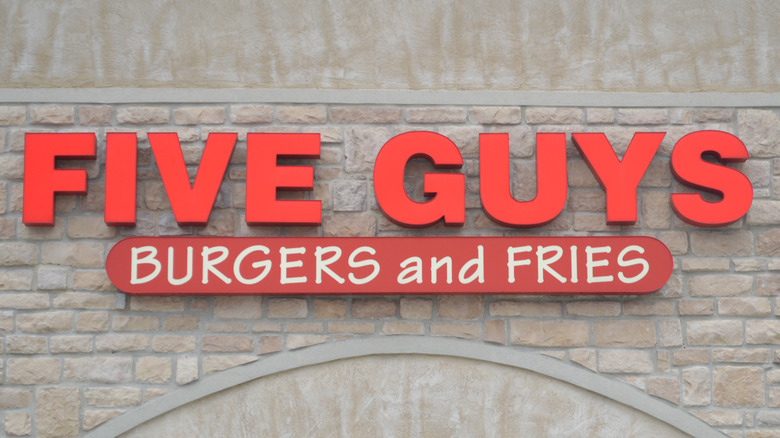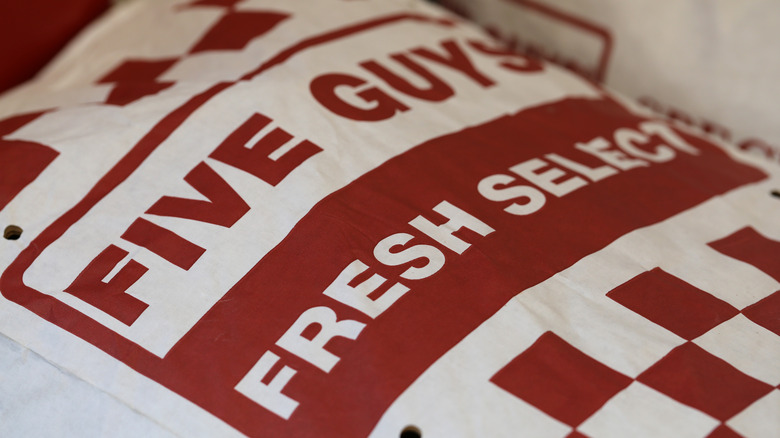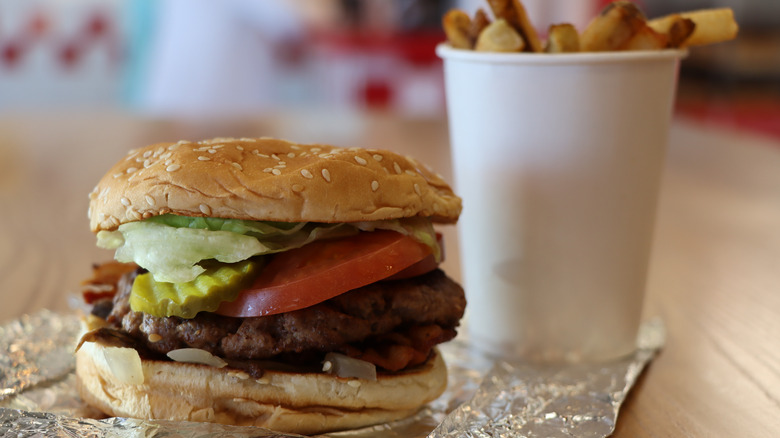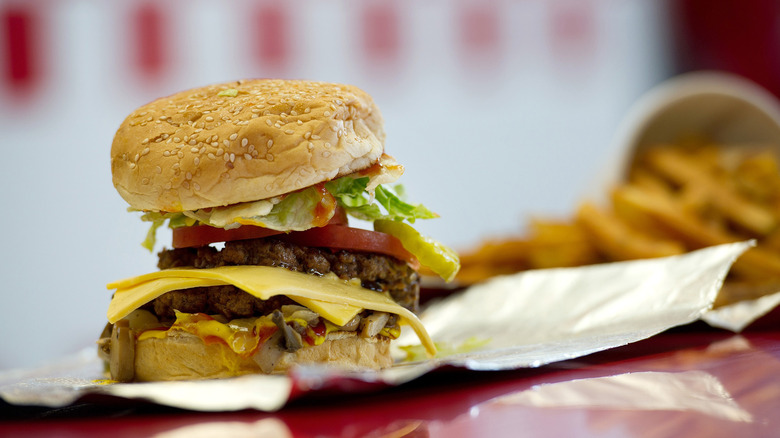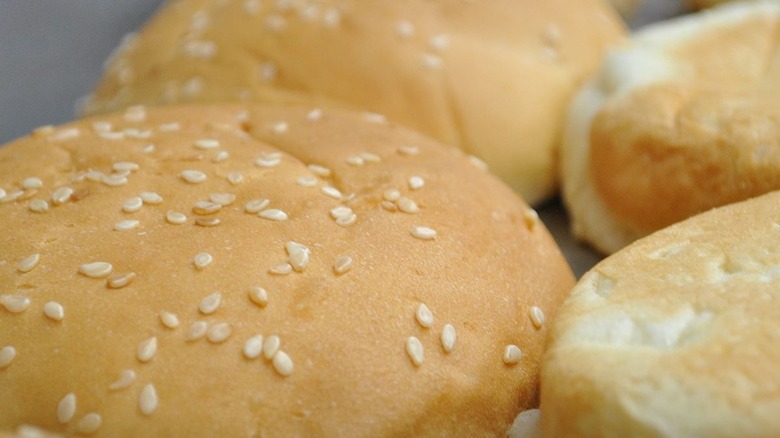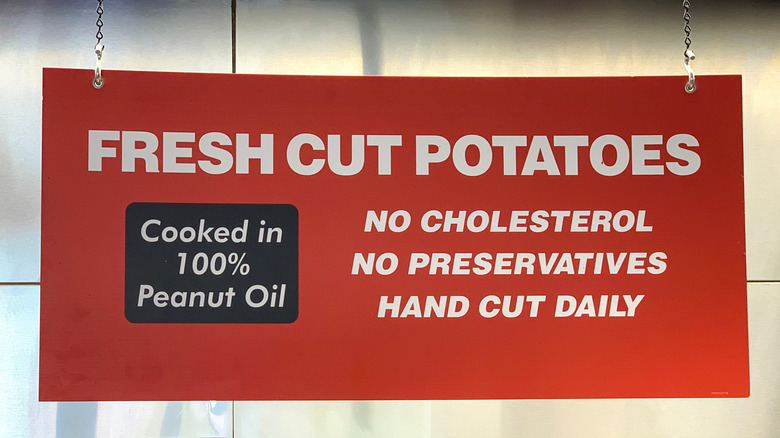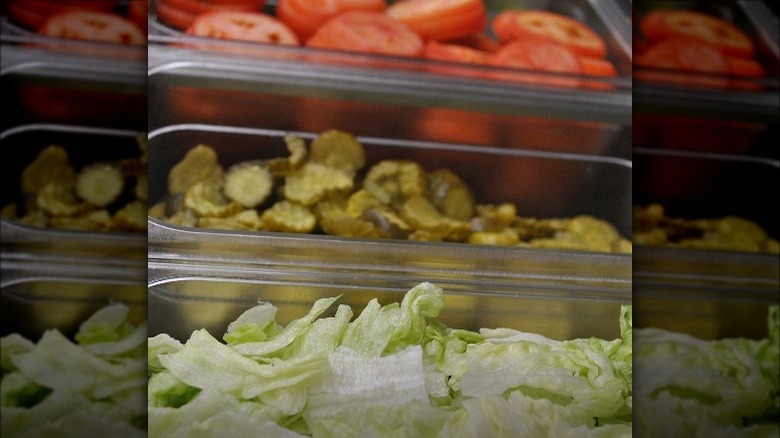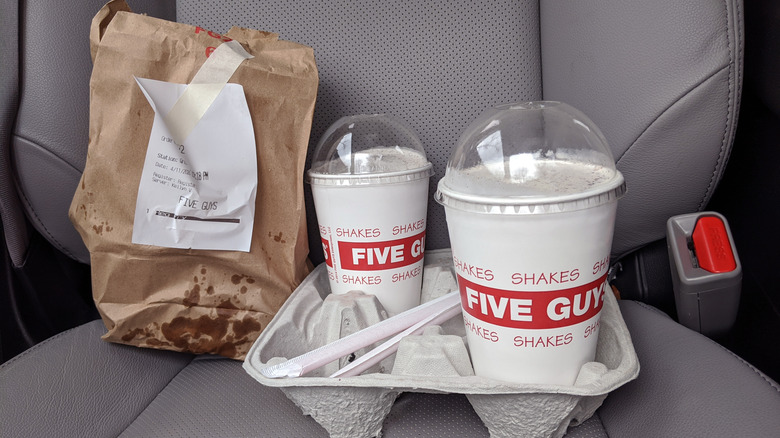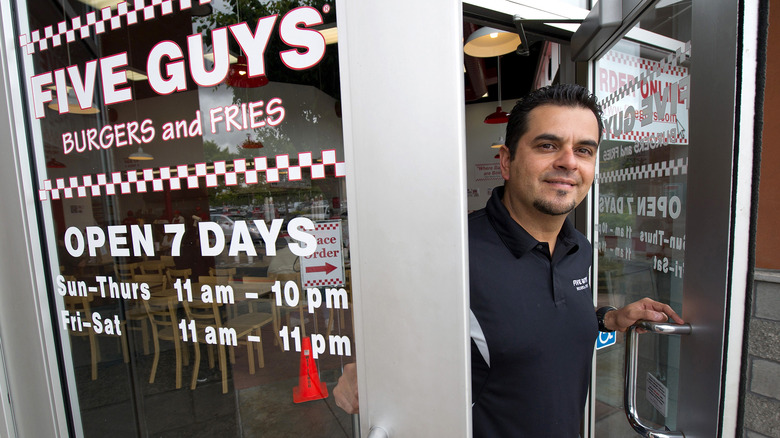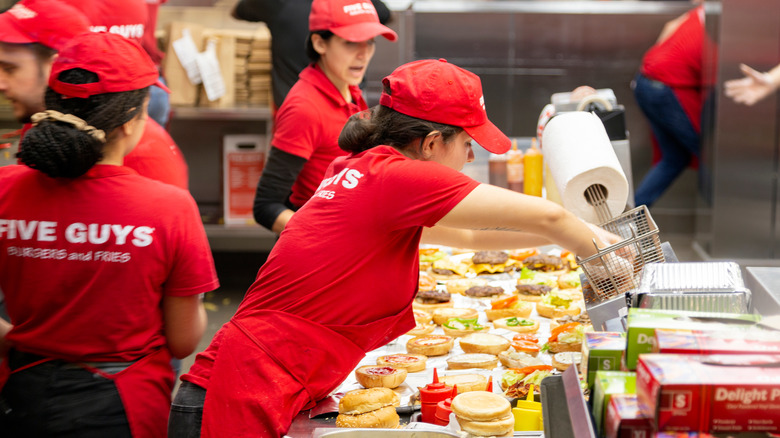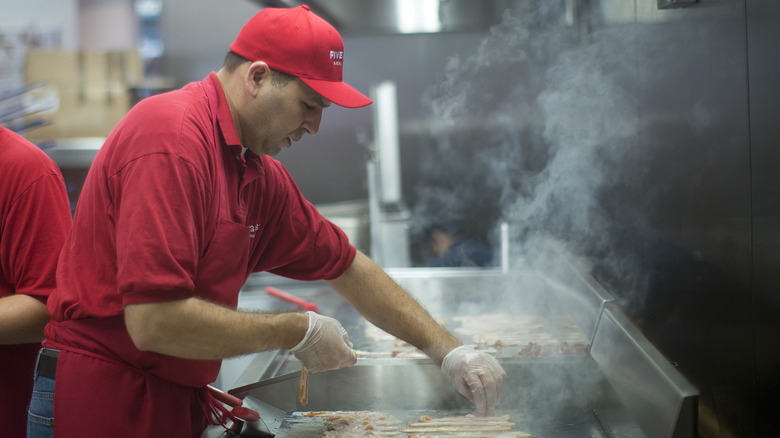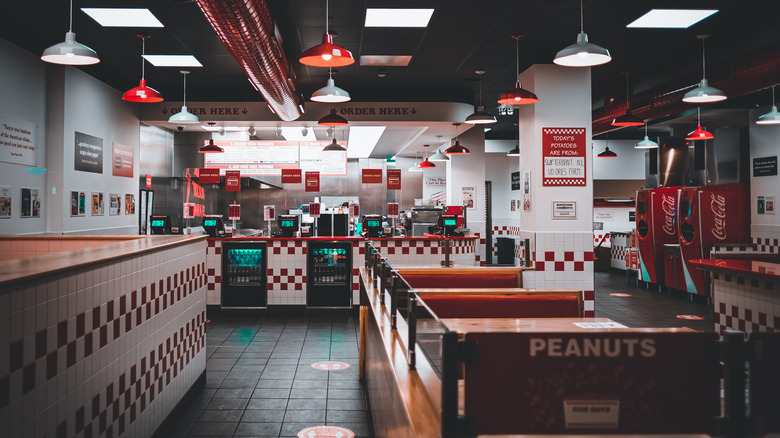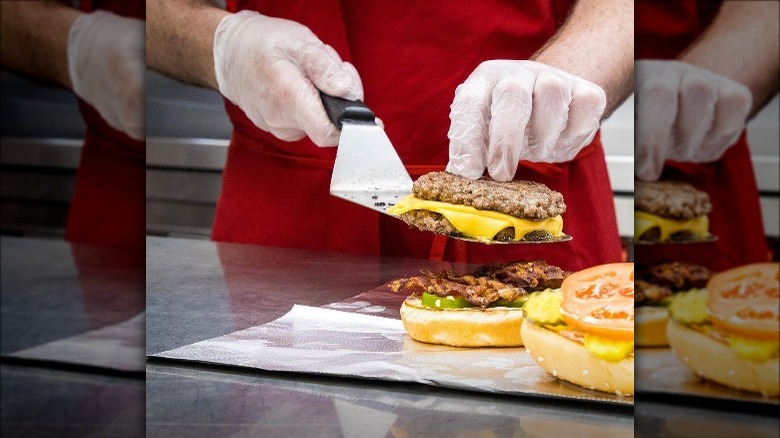We Finally Know Why Five Guys Is So Expensive
Back in 1986, a stocks and bonds salesman named Jerry Murrell decided to open a little burger diner with his wife and sons, which he branded Five Guys (representing each one of his sons). Who would've thought that over 35 years later, his burger biz would have exploded to 1,700 locations and counting, and achieved international status. Murrell believes there are two main factors when it comes to the chain's growth: quality ingredients and consistency. Both are reflected in each one of his regulated locations, all the way down to the rules surrounding their infamous free peanuts.
Despite its major success, Five Guys isn't without a bit of drama. According to Business Insider, the burger chain is losing the interest of the most influential demographic in the world: millennials. Why? Millennials feel that Five Guys is downright expensive, especially for a fast-casual dining experience. However, compared to its competitors, Five Guys burgers are expensive. In Los Angeles, a standard hamburger will cost you a whopping $9.59. If you head to a competitor, like In-N-Out, you can get a hamburger combo, which includes a medium size fries and a medium soda, for $5.35.
There is no question that compared to other fast food burger chains, Five Guys is pricey, and the reasons that is the case will most definitely surprise you.
Five Guys only uses fresh ingredients
Unlike a majority of fast food or fast-casual burger chains, Five Guys is committed to freshness. This can come with a cost, which is most likely reflected in the price you pay for a burger at one of their establishments. The company refuses to work with frozen product which is reinforced by the fact that there are only coolers — no freezers — located in their kitchens. Working with only fresh ingredients has a catch: spoilage. That is, food that's expired, past its shelf life, or has just gone bad. In an interview with Quick Service Restaurant, C.W. Brunton, the Vice President of Operations for Saladworks says "working with fresh ingredients means there's a lot of waste. But if we're making small batches often — meaning prepping frequently — you have two benefits: One, is you're wasting less because the likelihood of having something expired is minimized, and then two is you get even fresher product."
He goes on to explain that to keep spoilage minimal, that might mean prepping two to three times a day, which means more deliveries. "If we need deliveries more often than that," he says, "we can accommodate." Take into account the fact that Five Guys also has multiple free toppings to choose from, along with their freshly baked bread that's delivered daily (more on those below), and it just seems logical that these costs would be calculated into the final menu pricing.
Their food is made with premium products
It's been established that Five Guys uses only the freshest ingredients, but what about their caliber? As you might imagine, Five Guys only invests in premium, high-quality ingredients. Schweid & Sons is the beef purveyor for all the Five Guys locations. The specialty blend of ground chuck and sirloin used for Five Guys burgers isn't available for retail purchase, which makes it all the more tantalizing. It's comprised of 80% lean and 20% fat ground beef, which, according to Schweid & Sons, is the ideal lean-to fat ratio.
Then, of course, there are the fresh (never frozen) french fries. According to Food Republic, each year Five Guys buys more than 5% of the annual Idaho potato crop, which is mainly of the Burbank (a type of Russet) variety. Annually, that amounts to 140 million pounds of potatoes. According to Capital Press, around 100 Idahoan potato growers sell to Five Guys.
Even the mayonnaise they use is a privately owned brand created by Murrell and the corporate condiment king, Heinz.
Five Guys does not skimp on size
Five Guys is known for being super generous with their portions, especially their fries (though a former employee on Reddit claims that this is just an illusionary tactic to make their portions seem larger than they really are). That being said, a small order of fries is still enough for two people.
According to Five Guys' nutritional information, their standard burger patty hovers just around 3.35 ounces (or 94 grams). In a Taste-off between two competing burger chains, Dallas Observer calculated that In-N-Out's patties weigh in at two ounces. That means a single burger at Five Guys is almost 50% meatier than their competitor. It almost seems comparable when you factor in cost — everyone likes a good deal and a happy stomach — except that the Five Guys standard hamburger doesn't come with one patty. It comes with two. That means you're actually getting 6.7 ounces of premium beefy goodness. So, if the price for a single burger at Five Guys makes you scratch your head, now you can see that you get what you pay for.
Their burger buns are baked fresh off-site
Whether you love them or hate them, the burger buns at Five Guys are something worth talking about. According to their Facebook page, Five Guys buns contain nine total ingredients: water, flour, sugar, oil, yeast, eggs, milk, salt, and sesame seeds. Compared to your standard burger bread, these buns are distinctly sweet and noticeably eggier (via NBC). While some locations have a love/hate relationship with the price of the bread, they have to stick with synchronicity because if it's one thing Five Guys takes seriously, it's keeping their menu items — and locations in general — all uniform. So even if the buns are a costly sore point, franchisees know that the product is premium (and that they wouldn't be able to change it anyway).
To keep up with demand, the company contracted 10 professional bakeries around the nation to produce their fabulous cake-like buns. According to Jerry Murrell, the bread is baked on a daily basis and picked up at 3pm every day. The buns are then shipped out via plane or freight, and sent to every Five Guys location (there are currently nearly 1,700 worldwide) so that they arrive in time for prep early the next morning, regardless if the nearest eatery is 400 miles away (via Inc.). That is a lot of buns and a lot of gas to account for.
Peanut oil is their pricey go-to for fries
According to PitCo, canola oil and peanut oil (or a blend of both) are the most commonly used fryer oils in the restaurant industry. That being said, eateries tend to steer clear of peanut oil because of the price, not because it's a threat to individuals with nut allergies. According to Managing Peanut Allergies, people with peanut allergies are allergic to the protein in the actual nut. Refined peanut oils — like the ones used by Five Guys — are considered "clean" oils (aka "refined") and undergo multiple processes to eliminate any proteins (via The Achoo! Blog).
You would think that the significant increase in childhood nut allergies (via Very Well Family) would cause peanut oil prices to plummet, so why is it the opposite? Healthline reports that peanut oil is one of the most nutrient-dense oils in the world and is high in oleic oils (omega-9) and vitamin E. There has been an ongoing shift towards healthier eating, especially in the fast and casual-fast food industries, per QSR magazine. This growing interest has increased demand on the peanut oil manufacturers, who are having trouble keeping their supply up (via Miss Vickie Pressure Cooker Times). Ultimately, menu prices are going to reflect the price of goods needed for the production of menu items, which Jerry Murrell has been open about (via Inc.), so it wouldn't be a surprise if the cost of peanut oil plays a factor in the pricing of Five Guys' menu.
Toppings are free — but are they really?
There's no such thing as a "free" topping. Free means you're not paying at all. You need to take into account the price of Five Guys burgers, coupled with the knowledge that the restaurant chain only uses premium ingredients. That means that those free toppings have to be calculated into the cost of something somewhere. After all, the chain has to pay for those toppings — they're not magically gifted from some benevolent toppings' god.
Five Guys technically has 17 different toppings that you can add to your massive burger. All of them are free. While their menu only specifies 15 — ketchup, mustard, relish, specialty mayonnaise, grilled onions, grilled mushrooms, Mount Hood pickles, fresh lettuce, tomato, onions, jalapeños, green peppers, BBQ sauce, hot sauce, and A1 steak sauce — you can also add extra cheese and bacon without charge.
It comes down to this: Restaurants want to make money. They can advertise that additions are "free" (especially if they cost only a trivial amount, like ketchup or mustard packets), because those food costs are minimal. But everything is calculated into the final price you pay for your meal. This is done using food cost calculators, like the ones found at Webstaurant Store, which calculate food margin, percentages, and pricing based off of a restaurant's food costs. In the end, you're paying for those free toppings, whether you realize it or not.
Their packaging can be unnecessary
It's Five Guys standard that every meal served is treated as a to-go order and is packaged as such, even if the customer is dining in. Keeping everything bagged is, in all honesty, a good thing. It keeps the Five Guys locations all in line with one another, helps to keep potential messes at bay — because there's nothing worse than cleaning up an accidental tray drop — and also gives the customer the option to dine in, even if they had originally intended to take away and eat elsewhere. It's also a Five Guys advertising tactic, as revealed by an alleged former employee on Quora.
Taste of Home reports that there are some customers who are upset about packaging everything to go, because bags equal more waste. Once paper bags become wet or greasy, you can't recycle them (via Napa Recycling). But since bagging everything to go is part of the Five Guys advertising strategy, it probably won't be going away anytime soon. But bags cost money — even if they're inexpensive — and that needs to be factored in somewhere. Every penny counts.
Opening a new store isn't cheap
If the thought of owning a Five Guys franchise has been sizzling in the back of your mind, be prepared to fork over a fair amount of dough. According to Forbes, potential franchisees have to first pass a QA test: a net worth of at least $1.5 million and a minimum of $500,000 in liquid assets. If you pass the test, you can then expect to make an initial investment of $306,000 to $641,000. There's also a little $25,000 franchise fee. In an interview with Monsoon Martin, Molly Catalano, the Director of Communications and Public Relations for Five Guys, mentions that "Five Guys sells exclusive territories to franchisees. A franchisee must purchase a territory with a minimum of five locations."
So, you're not just overseeing one location — it's five minimum. Forbes reports that Five Guys pockets 6% of each location's gross profits, and 1.5% is collected and used for secret shoppers who inspect each location on a weekly basis for cleanliness, service, and safety compliance. That being said, franchisees can expect to bring in an average of $1.2 million annually (via Forbes). So, while the initial investment is pretty high stakes, the pay-out may be worth it.
Employees go through rigorous training
According to EduMe, any given organization can spend around $1,152 on training and development per employee. When it comes to restaurants, each role has its own specific training regime. It's no different at Five Guys. Since the food is freshly prepped and made to order, cooks are expected to know what they're doing. To make sure they have what it takes to man the grill, employees must first have acquired the knowledge and tools through proper training. It's imperative that they have these skills, because timers aren't allowed in the kitchen.
French fries have to be shaken 15 times (and only 15 times), and NBC News reports that potential fry cooks attend "fry calibration" class before being able to man the fry station. Burger builders need to learn the specific way to arrange toppings, or the texture won't be right. Obviously, these are all on-the-job paid training sessions. They're incredibly in-depth and are also mandatory. In fact, no employee is allowed to work a full day without attending Five Guys University.
At Five Guys, consistency is key, and if something tastes off or is out of place, then it reflects poorly on the brand. So if you're wondering if training is calculated into the price of your burger, Chron. confirms that yes, labor costs (like training and employee salary) are most definitely factored into the cost of food.
They invest in their employees
Not only does Five Guys offer ample and thorough training for employees through their Five Guys University, full-time employees qualify for retirement savings and health insurance, as reported by Home Business. All of their employees get a paid (aka "free") meal per shift and 50% off food when they're not on the clock. The company also offers bonuses twice a year. Although it doesn't seem like this would be reflected in the price, those perks need to be accounted for somewhere.
Five Guys also wants to invest in their employees' education. As stated on their website, the company has a Tuition Assistance Program that offers "eligible employees the ability to enroll in 40-plus high school and college degree programs specifically designed for busy, working adults." They offer three different programs: fully funded coverage (employees receive 100% tuition coverage for select degrees in business administration, hospitality management, and finance), partially funded (employees receive up to $5,250 per year for tuition that's applicable to a broader range of associate and bachelor's degrees), and also personalized coaching that helps guide new students.
There's a lot of daily interior upkeep
If you've ever been to a Five Guys, you know that visually, they have a lot going on. The walls are covered in white and red tiles, the kitchen has an open floor plan with a shiny steel interior. An open floor plan means everyone can see inside, and everyone can see everything. There are no hiding messes of any kind, which means cleanliness is even more important. If a customer sees something questionable, that reflects poorly on the brand.
To keep the stress off the cooks, free peanuts are offered in a communal barrel in the waiting area. While this is offered as a kind gesture (as well as a way to keep customers preoccupied and not eagle-eye the kitchen crew) it means there's more of a mess for employees to clean up, especially since customers have a tendency to just leave their peanut shells on the floor. If you factor in the extra sanitation and cleanliness regulations initiated by the FDA (because of the pandemic), that means even more extra costs. Ultimately, the cost of cleaning — and extra regulatory sanitization — means more money spent. Wonder where those costs are added?
They'd rather raise the price than compromise on quality
Jerry Murrell has been very open about the Five Guys pricing. In an interview with Inc., he reveals, "Our food prices fluctuate. We do not base our price on anything but margins. We raise our prices to reflect whatever our food costs are. So, if the mayonnaise guy triples his price, we pay triple for the mayonnaise! And then we'll increase the price of our product."
Basically, depending on where you are in the world, the price you pay for your burger is going to vary. Take, for example, the 2016 debut of Five Guys in Belfast, Northern Ireland. While customers were happy with the burger, they felt that the prices, which were higher than what Americans were paying at the chain, was shenanigans. Five Guys defended the increased prices by citing taxes, the use of premium ingredients, and the cost of labor.
A while back, a massive crop of tomatoes was cleaned out by hurricanes in Florida. Murrell received calls from franchisees who were pulling tomatoes off the menu because they were too expensive (the price has jumped from $17.00 a case to $50.00). Every hamburger comes with two slices of tomato, so Murrell suggested that until the price decreased, only one slice was necessary. But his sons intervened and made sure that franchisees kept two because, well, consistency (via Inc.).
The cost of food waste can add up
It's already been mentioned that Five Guys takes pride in their no-freezer policies, instead, sticking to coolers and food that's prepared fresh daily. That's the kicker: If something is prepared fresh daily, that insinuates the items in the cold case are, in fact, prepared that morning and not the day prior — because that's not fresh and wouldn't be in line with the Five Guys values. Five Guys encompasses the fresh-food factor because fresh makes food taste better.
According to Food Print, it's estimated that restaurants in the United States generate upwards of 22 to 33 billion pounds of food waste annually. That being said, most restaurants have a general idea of how many customers they'll have on each day, and that helps determine how much product will be needed, ultimately leading to consistent pricing. This food waste forecasting can be done by using prep calculators (via UpKeep).
It's interesting to note that in a study by Unilever, 47% of diners said they would be willing to spend more money to eat at a restaurant that actively tries to reduce its food waste output. Perhaps Five Guys has taken this into account, too.
A lot of money goes into mystery shoppers
It's Jerry Murrell's firm belief that the best marketing and advertising comes from word of mouth, not some billboard or prime-time commercial slot (via NBC News). Five Guys also doesn't solicit reviews. Instead, they use mystery (or secret) shoppers as their main form of advertising. Murrell tells Forbes that Five Guys collects 1.5% from their franchisees to cover the cost of mystery shoppers that frequent each location twice a week (via Canadian Viewpoint).
According to a poster on Quora who claims to be a mystery shopper for multiple businesses, working for Five Guys was one of their better gigs. "I was particularly pleased to see that corporate watched a number of important details," they wrote. "They asked that we observe how the fries were cooked, the quality of the finished product and the cleanliness of the restaurant — among a number of details important for good customer service."
This attention to detail is certainly reflected in the high quality of the Five Guys experience, but of course, it comes at a price.
